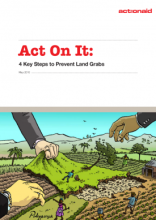Land Library
Welcome to the Land Portal Library. Explore our vast collection of open-access resources (over 74,000) including reports, journal articles, research papers, peer-reviewed publications, legal documents, videos and much more.
/ library resources
Showing items 1 through 9 of 82.Author: Robyn Pharoah/ActionAid
Ten African countries have signed up to the New Alliance for Food Security and Nutrition – the G8 countries’ main strategy for supporting agriculture in Africa that was launched in 2012. As the New Alliance has been under way for three years, some of its likely impacts are becoming clearer.
In 2008, three sugar companies were awarded nearly 20,000 hectares of Economic Land Concessions (ELCs) in Oddar Meanchey province.
Over the past 15 years, tens of millions of hectares of land have been acquired by large investors in developing countries.
The 2003 Maputo Declaration on Food and Agriculture committed signatory countries across Africa to a 10% allocation of national budgets to agriculture by 2008. To bolster the implementation of this commitment, the Comprehensive Africa Agriculture Development Programme (CAADP) was established.
The new India’s Right to Food Campaign website was launched in March 2014 at the campaign’s fifth convention.
Less than 2% of the land available worldwide is owned by women. Why is the issue of land so gendered? What approaches and lessons learned can development professionals utilise to address the issue of gender and land?
The Integrated Drylands Development Programme (IDDP) is a global UNDP initiative to promote sustainable development in the drylands, and advance the implementation of the UN Convention to Combat Desertification.
In Africa, the pursuit of gender equality in inheritance rights remains one of the most difficult challenges due to its entrenched patriarchal characteristics. This is also the case in the rural communities of South-Eastern Nigeria.






